|
|
|
Sort Order |
|
|
|
Items / Page
|
|
|
|
|
|
|
| Srl | Item |
| 1 |
ID:
126118
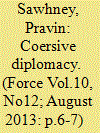

|
|
|
|
|
| Publication |
2013.
|
| Summary/Abstract |
In an unexpected development, a Chinese border guards' platoon (30 soldiers) moved in and pitched tents 19 kilometres inside Indian territory at Depsang Valley overlooking Daulet Beg Oldie (DBO) on 15 April 2013 in Ladakh in the Western sector. The last time they did a similar thing was in 1986 in Sumdorong Chu in the Eastern sector (Arunachal Pradesh). Both times, the Chinese forces had blessings from the highest quarters: then supremo Deng Xiaoping and now the President and chairman of the Central Military Commission, Xi Jinping. Then, the Chinese were not a risen power and the occupation of Sumdorong Chu, of little tactical significance, was meant to test Indian gumption, through military coercion, after the passing away of Prime Minister Indira Gandhi, who Deng admired for being a strong and determined leader. There was a year-long stand-off with menacing military build-up on both sides ending in a mutually agreed disengagement with neither side looking a loser. The Chinese finally left Sumdorong Chu of own free accord in 1995. China's military coercion had not worked for two reasons: India showed political will, and China's military capability did not match its coercion.
|
|
|
|
|
|
|
|
|
|
|
|
|
|
|
|
| 2 |
ID:
125506


|
|
|
|
|
| Publication |
2013.
|
| Summary/Abstract |
The India-China border dispute has been subject of much debate, discussion, and analysis over since the Sino-Indian war of 1962. However, the developments on the India-China border in the western sector in April 2013 brought to the fore the sensitivities of the border dispute between India and China which remains unresolved till today.
|
|
|
|
|
|
|
|
|
|
|
|
|
|
|
|
| 3 |
ID:
125365
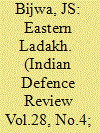

|
|
|
|
|
| Publication |
2013.
|
| Summary/Abstract |
The Armed Forces are India's "hard-power" assets and not a tool for diplomacy on the borders. Deployment of an armed force to support a diplomatic effort is axiomatic as it lends strength to diplomacy. Should "soft power" of diplomacy fail, then the will to suitably demonstrate use of "hard power" must not be found wanting. India is a Nation tugging at its leash to surge forward in all arenas of development. Without throwing caution to winds, there is a requirement to be less tentative and more assertive. India's national interests must be paramount. At stake here are the aspirations of a young generation for a bright progressive future.
"Perform necessary action; it is more powerful than inaction; without action, you even fail to sustain your own body." -Mahabharata
|
|
|
|
|
|
|
|
|
|
|
|
|
|
|
|
| 4 |
ID:
124699
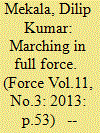

|
|
|
|
|
| Publication |
2013.
|
| Summary/Abstract |
On October 24, Indo-Tibetan Border Police (ITBP) celebrated its 52nd anniversary with a ceremonial parade at the Tigri campus, New Delhi. Looking back at the past year, ITBP can't seem to deny that this has been the most challenging year for their personnel. Starting with the incursions of the Chinese Army at the Line of Actual Control (LAC) in April, which led to the face-off between the Chinese and the Indian forces at the border, to the Uttarakhand flood rescue efforts, considered the biggest ever operation till date, the ITBP faced tough challenges this year. This was again followed by more incursions from the Chinese Army in the subsequent months.
But the good news is that the ITBP is getting a major push from the government to develop its infrastrusture both at the border and its various headquarters in the mainland. Speaking at the Raising Day parade, chief guest R.P.N. Singh, minister of state (Home) said that the government has sanctioned Rs 1,260 crore for construction on the ITBP locations. It includes accommodation for jawans, construction of forward locations and other operational and administrative buildings and structures. He also said that measuring eco-friendly stride towards energy requirement, a total of 69 forward ITBP posts would soon have three to 10 KVA solar power plants which will facilitate uninterrupted power supply for various needs.
|
|
|
|
|
|
|
|
|
|
|
|
|
|
|
|
| 5 |
ID:
131046
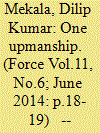

|
|
|
|
|
| Publication |
2014.
|
| Summary/Abstract |
Ever since the border face-off between Indian and Chinese Troops in the Depsang Bulge at the Line of Actual Control (LAC) in April 2013, the Indian Army has raised its pitch to acquire Operational Control of the Indo-Tibetan Border Police Force (ITBP). But that one incident couldn't have been the trigger, and it's not correct to dismiss ITBP's role in handling the situation. After all, the ITBP had followed all international protocols which ultimately led to the solution through diplomatic channels.
The Indian Army cannot be deployed along the forward posts at the LAC according to various UN conventions. So naturally when the Chinese troops entered the Indian territory close to the Burtse post in the Depsang Bulge, the ITBP was the first respondent. According to a source privy to the information, when the Chinese patrol team was observed coming close to the Burtse post, roughly around one-and-a-half or two kilometres away, the ITBP teams responded immediately. As per the Standard Operating Procedures (SOP), the ITBP has to inform all the stakeholders in events such as this. Sources claimed that the information was indeed relayed to all the stakeholders like National Security Advisor (NSA), defence ministry, Indian Army and various intelligence agencies in real time. The ITBP boasts of its quick communication to as many as 11 agencies involved in resolving the stand-off.
|
|
|
|
|
|
|
|
|
|
|
|
|
|
|
|
| 6 |
ID:
126007
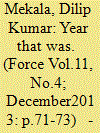

|
|
|
|
|
| Publication |
2013.
|
| Summary/Abstract |
Another eventful year is coming to an end and this time there is a lot to be cheerful about. For the defence and the paramilitary forces, the year 2013 has been fruitful in terms of their force modernisation. Even the defence industry managed to find satisfaction in some of the advances made in the long and tedious defence procurement.
On the other hand, instances of infiltration, cross border firing and border incursion from neighbouring armies cast a pall of gloom in an otherwise successful year. In addition, there were tragic and extremely challenging situations which the government and the forces faced, such as the devastating floods in Uttarakhand, INS Sindhurakshak mishap and so on. But overall, it has been an eventful year. Let's look at the major events in Indian defence in 2013.
|
|
|
|
|
|
|
|
|
|
|
|
|
|
|
|
|
|
|
|
|